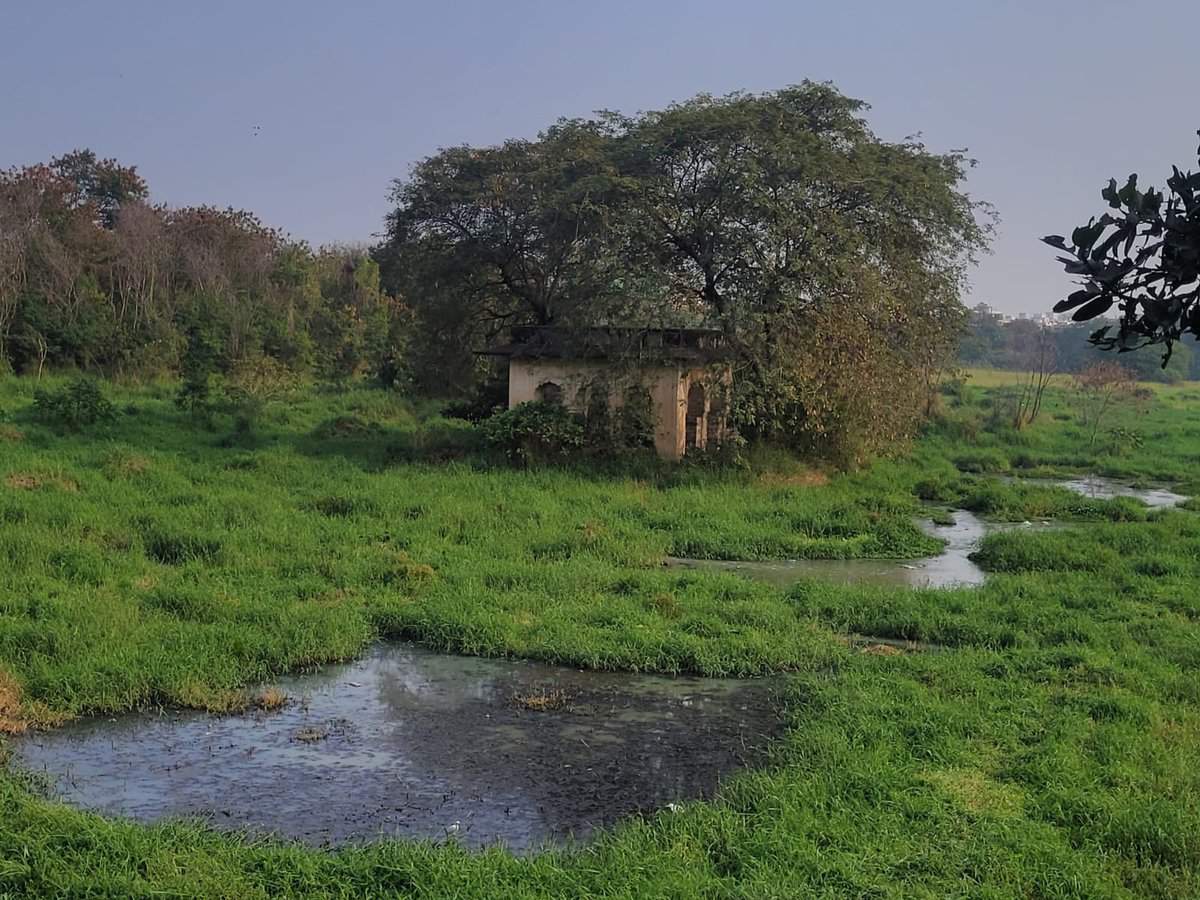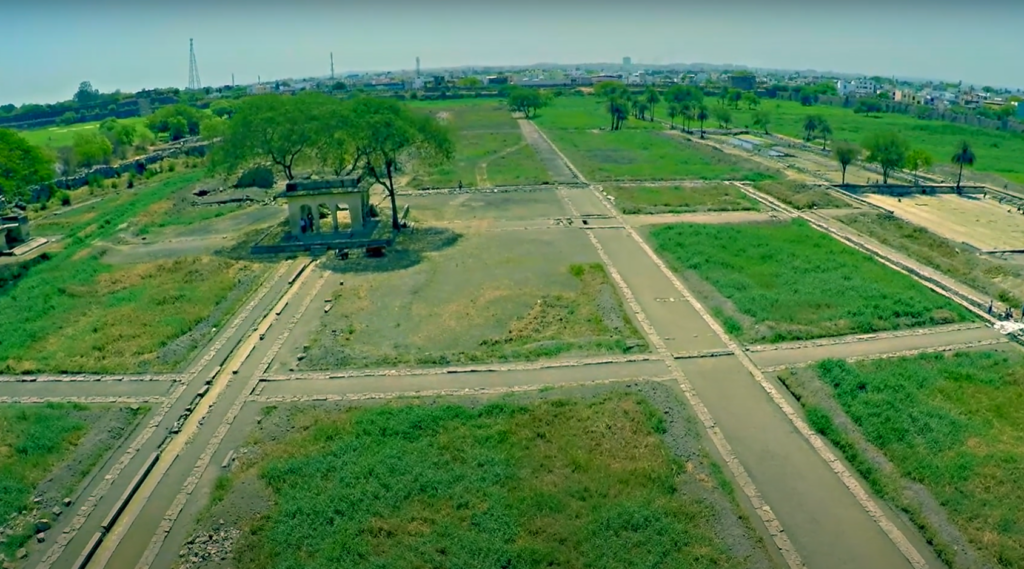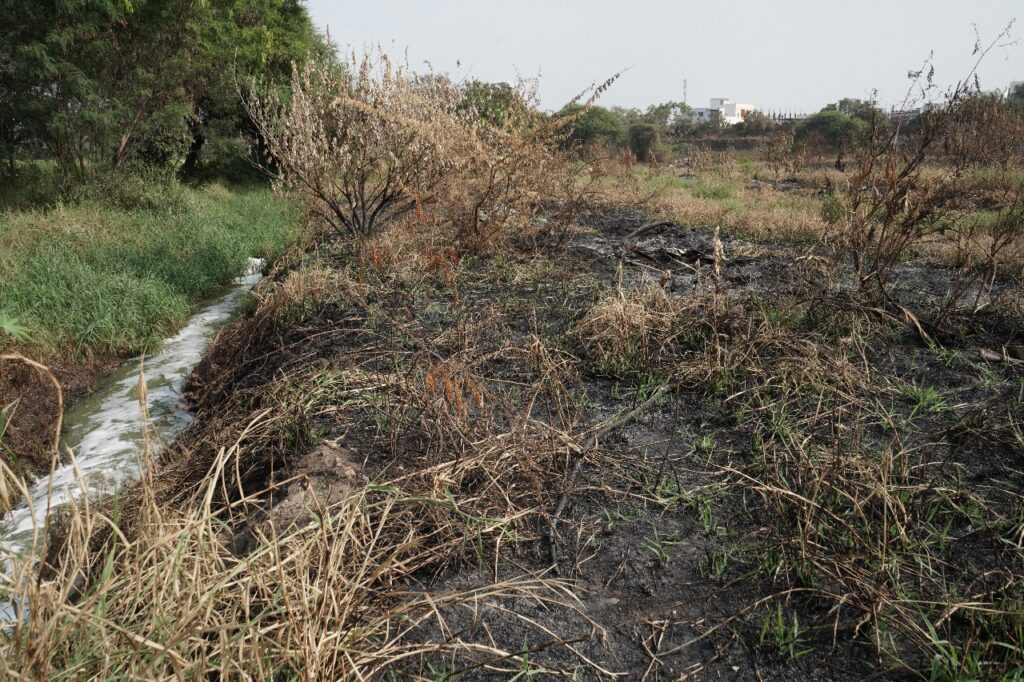
Hyderabad: The situation in Naya Qila, an extension of the historic Golconda fort comprising historic gardens and other monuments of the Golconda period, has become worse in recent days as its custodian, the Archaeological Survey of India, has not repaired damaged nalas in the premises since months. It has resulted in one of the Baradaris, or garden pavilion, now in danger of getting flooded thanks to waste water being diverted to it.
While locals allege that the Hyderabad Golf Course Association (HGA), which occupies half of Naya Qila, is diverting wastewater from the Shah Hatim Talab into Naya Qila, ASI officials said that work to repair the nalas will begin soon. It may be recalled that last year the ASI also stopped the HGA from undertaking extension works without seeking permission. The association has been over the year slowly encroaching more and more into the Golconda Fort’s Naya Qila area, and has its own security ant entry gates who often prevent people from visiting monuments in the area.
The ASI had excavated Naya Qila five years ago using Ground Penetration Radar technology in 2017. The historic part of the Golconda fort has two mosques – Mulla Khyali and Mustafa Khan -that predate Hyderabad, apart from other monuments like the Laila and Majnu bastions. It also has a baobab tree that was planted there over 400 years ago by travelling Africans.
Last year, the road in Naya Qila connecting to the tree had collapsed after which HGA security have been disallowing the public from entering the place. ASI officials however have said that they have their own guards there and that the HGA has no rights whatsoever to restrict people in any way. People can visit the mosques, the tree and the bastions without any restrictions.

“It’s been quite sometime now. Ever since the road connecting to Hatiyan ka Jhad (Baobab Tree) caved in near the canal, forthy water from Shah Hatim Talab into Naya Qila Talab is now diverted straight into this side (near the pavilion) next to the golf course,” a source said.
The HGA, which has had plans to expand its course, also allegedly burned a part of the marsh at Naya Qila (towards west of the Baradari) to extend their grass carpet, confirmed locals.

According to locals, the HGA has already laid green carpets to extend the golf corse over the Naya Qila site, that was developed after the first Mughal attack on Hyderabad in 1656. Thie Persian Garden there houses a pavilion, a tank, a well, and a water cascade. During excavation, ASI recovered artefacts, including fragments of Hukkahs and potsherds.
The porcelain ware yielded at this site talks about the exchange of trade activities with China. The site also reported a few Mughal coins, a ASI description at the site reveals. According to ASI documentation at the site, “With intent to understand the water management system at Bagh-e-Naya Quila, the scientific clearance was started in the south-east of Dal Badal Chabutra in the years 2014-2015 by Hyderabad Circle of ASI.”
During the course of scientific clearance, a layout of Chhar Bagh (Persian garden) was exposed along with water tanks, water channels, fountains, drains, aqueducts, and terra cotta pipelines, which unveiled the water management system in vogue.
Naya Qila history
The Naya Qila area is in fact believed to be about over 400 years old, and is a part of the Golconda dynasty’s (which founded Hyderabad in 1591) remaining heritage in Hyderabad. The Naya Qila area, which is now cut-off from the Golconda fort due to local encroachments, was developed into an external fortification after the first Mughal attack (during the time of Emperor Shah Jahan) on Hyderabad in 1656.
It has two huge bastions called Laila and Majnu, of which Majnu continues to be in a state of disrepair after its collapse during monsoons in 2021. The ancient historic site was one of the few places which witnessed damage during heavy rains in 2021 in the fort. The Archaeological Survey of India (ASI), which runs the historical site, was supposed to undertake repairs, but that has not happened so far as well.
Other parts of Naya Qila which are open to the public are the Baobab tree, which is believed to be over 400 years old (it is said to have been planted there by African friars), the Mustafa Khan Masjid (which was built in 1561 and predates Hyderabad), and the Mulla Khyali Masjid, which is believed to be named after the Deccan poet Mulla Khyali.
While the Majnu Bastion’s collapse is the latest instance of the city’s heritage getting damaged, in the past the HGA had also disallowed the general public from entering the Naya Qila area. However, according the ASI, there is no such restriction and the public is free to visit the place.
The Golconda Fort and the Charminar are two monuments that fall under the jurisdiction of the ASI, which works the central government, while all the other heritage sites like the Qutb Shahi Tombs come under the purview of the Archeology Department of Telangana government. Last year, a petition A petition was also created to save Naya Qila and the Golconda fort by local Hyderabadis.
History of Golconda Fort
The Golconda Fort’s origins are traced back to the 14th century when the Rajah of Warangal Deo Rai (under the Kakatiya Kingdom which ruled from Warangal) built a mud fort. It was taken over by the Bahmani Empire between 1358 and 1375. Later, it was developed into a full-fledged citadel by Sultan Quli who founded the Qutb Shahi kingdom in 1518 following the death of last sovereign of Bahmani Emperor Mahmud Shah.
Sultan Quli was a commander and later governor of Tilang (Telangana), under the Bahmani Empire (1347-1518), when its second capital was at Bidar. Sultan Quli, who was originally from Hamadan in Iran, rose to the level of Governor under the Bahmani Empire in early 16th century. At this point of time he was given the fort, around which he began developing a walled-city. It eventually came to be called Golconda Fort (name derived from Telugu Golla-conda, or shepherds hill).
The fort has 87 bastions, and eight gates, of which a few are not accessible to the general public as they are under the army control. It is believed to be one of the Deccan’s most impregnable forts, and had kept Mughal emperor Aurangzeb’s army at bay for eight months until he succeeded and conquered Hyderabad in 1687.
Hyderabad was founded in the year 1591 by Mohd. Quli Qutb Shah, the grandson of Sultan Quli, with the Charminar being the city’s foundation. The city turned 429 years old in 2020.



